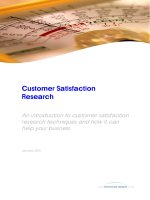Customer SatisfactionResearch
Bạn đang xem bản rút gọn của tài liệu. Xem và tải ngay bản đầy đủ của tài liệu tại đây (259.59 KB, 11 trang )
Customer Satisfaction Research
Customer Satisfaction
Research
An introduction to customer satisfaction
research techniques and how it can
help your business
January 2001
Customer Satisfaction Research
fact sheet I 2/11
‘an introduction to customer satisfaction research’
The majority of organisations today, both public and private, include customer satisfaction as a
primary business or organisational objective. Indeed, most aim to deliver high levels of customer
satisfaction and many have made significant investments in Customer Care or Customer Service
programmes. The ability to set customer satisfaction objectives is dependent on the
organisation’s ability to understand the priorities of its customers in the first place, and
subsequently to put in place mechanisms to measure accurately levels of customer satisfaction.
Customer Satisfaction Measurement (CSM) is the term used by market researchers to describe
broad research activities that help to understand and measure customer satisfaction. This
document provides an overview of why CSM is important to all organisations no matter how large
or small, outlines the objectives of different types of customer satisfaction research studies, and
highlights some of the primary objectives of effective CSM programmes.
Why Measure Customer Satisfaction?
Most businesses lose a certain proportion of their customers in every year they trade, and in many
cases the customer is lost because they have defected to the competition. This is often referred
to by marketeers as ‘customer decay’ or ‘customer attrition’. In some markets, the average
attrition rate is between 10 and 30%! There are many reasons why a customer defects, but
without a doubt the primary driver is dissatisfion with the product or service being offered.
Providing organisations can replace the lost customer with a new customer, ‘customer decay’ is
not necessarily perceived as an urgent problem. But ‘customer decay’ should in fact be a
problem for all organisations and ignoring it is both dangerous and inefficient.
The underlying logic for minimising `customer decay’ is simple: the cost of acquiring new
customers is higher than the cost of retaining existing customers. As we shall see, there is such a
thing as an unprofitable customer and, therefore, circumstances when acquiring new customers
is a better strategy than holding on to undesirable customers, but in general it is now a widely
accepted business theory that customer retention optimises profitability.
So, there is a fundamentally good reason for measuring customer satisfaction: understanding
customer needs and delivering high levels of customer satisfaction ensures a high levels of
customer loyalty, and this in turn enhances profitability.
For public sector organisations also, customer loyalty is a key measure of their performance.
Public sector bodies which provide excellent service to their “customers” are fulfilling a key tenet
of contemporary public service philiosophy and most government departments now set rigorous
requirements for meeting the highest customer service standards.
Customer Satisfaction Research
fact sheet I 3/11
‘an introduction to customer satisfaction research’
Defining Customer Loyalty – three underlining principles
In the early 1990s UK supermarkets, followed by a host
of other retail businesses, began introducing new
consumer incentive schemes usually referred to as
loyalty programmes. If customers signed up to the
loyalty scheme and continued to shop at the
supermarket with their personalised loyalty card, they
would enjoy regular price discounts on their
purchases through accrued loyalty points. Years later
some of those supermarkets withdrew their loyalty
schemes because they realised loyalty wasn’t so
easily bought. Indeed, it became clear that many
customers were simultaneously holders of several loyalty cards from competing supermarkets!
More recently, internet retailers basing their customer loyalty strategies purely on discounted
pricing also found to their dismay that customers were only loyal to the latest highest discount.
First principle – loyalty isn’t bought cheap
Loyalty is not bought through discounts or cheap bribes. Demonstrating competitive pricing can
have a crucial role in winning or retaining customers, but this has to be seen in a wider context of
a valuable product or service proposition. The most effective way to retain profitable customers
is, therefore, to offer a product or a service package which the customer values as superior to the
competition. But before you can put together a value proposition which will generate customer
loyalty, you have to understand what customers really value the most.
Second principle – there are different types of loyalty
The second principle of loyalty is about differentiation. Your customers are not a homogeneous
group; they do not all have the same buying characteristics. Equally, there are fundamentally
different types of customer loyalty.
Customer Satisfaction Research
fact sheet I 4/11
‘an introduction to customer satisfaction research’
At the bottom end of the scale there are customers who are simply
‘locked in’ with their supplier or have limited scope to change supplier
regularly. This is not uncommon in business to business markets. For
example, the significant investments made by manufacturing
companies to acquire ERP software stops them purchasing new
systems regularly. They are, to all intents and purposes, ‘locked in’ with
their supplier for a minimum of a few years no matter how dissatisfied
they may be with its performance. Consumers are in a similar position
with monopoly suppliers - they are forced to be loyal. Customers who
are forced to be loyal are not really loyal at all. Loyalty, and more
importantly, genuine commitment to a supplier, is a voluntary action
and has to be earned ultimately by consistently giving the customer what they need.
1
.
C
o
m
m
i
t
t
e
d
L
o
y
a
l
t
y
4
.
`
L
o
c
k
i
n
'
l
o
y
a
l
t
y
2
.
H
a
b
i
t
u
a
l
l
o
y
a
l
t
y
3
.
I
n
c
e
n
t
i
v
i
s
e
d
L
o
y
a
l
t
y
Customer
Loyalty
Customer Satisfaction Research
fact sheet I 5/11
‘an introduction to customer satisfaction research’
The second type of loyalty is often referred to as ‘incentivised
loyalty’, as manifested by supermarket loyalty cards, airline ‘frequent
flyer programmes’ and pricing discounts among telecoms
companies (e.g. BT “friends and family”). As mentioned earlier,
loyalty cards or other incentive schemes are no guarantee of loyalty
and often only succeed in reducing the customer relationship to that
of price.
The third type of loyalty is sometimes called ‘habitual loyalty’. If the
customer continues to buy from a supplier merely because it is easier
to do so but without truly valuing the supplier’s products or services,
then the customer has a relatively low level of commitment to that
supplier. In these circumstances the chances of a new supplier
surplanting the incumbent is high and becomes more likely over
time.
In business to business markets the buying decision is frequently more complex than consumer
markets. In general, the higher the purchase value and the more important to the business of a
single purchase, the more likely the decision will be made by a group of influencers, users and
decision makers. But uncomplicated, low value, low risk purchases frequently become habitual
purchases.
It is also the case that in many business and industrial markets, companies will generally seek to
specify several sources of supply. Multiple sourcing helps companies to negotiate with suppliers
and minimises supply chain problems. In these circumstances, even the most loyal business
customer may be unwilling to rely on a single supplier.
The most valuable type of loyalty is often referred to as
‘committed loyalty’. Those customers who are committed to a
supplier place a lot of value in using that supplier. More
importantly, they believe their chosen supplier is the best choice
for them in the market as a whole. There are a number of
distinguishing characteristics to help identify the ‘committed
loyalist’: they tend to buy more products, more often and spend
a higher proportion of their budget on their chosen supplier; they
consider competitors less often and recommend their supplier
more willingly and frequently to colleagues; they are emotionally committed to their chosen supplier.
Hence, committed customers are a valuable asset. Truly committed customers are more like partners
than customers - they actively support the supplier and recommend the supplier to other customers. As
such, marketeers often refer to these types of customer as ‘loyal advocates’.









